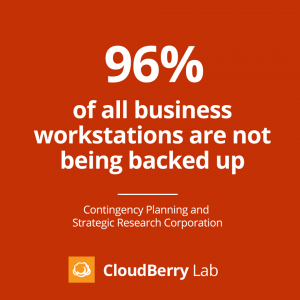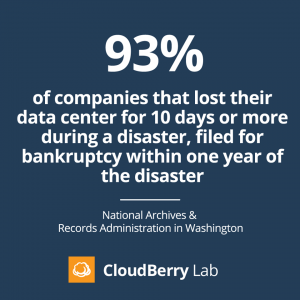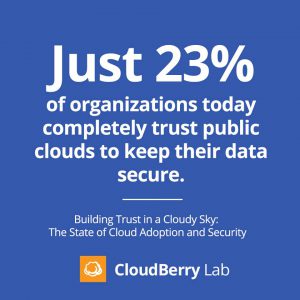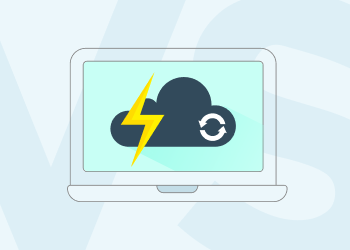Backup vs disaster recovery can be sometimes confusing: if you tell someone that your computer crashed, the first question you usually hear in response is: “Did you back up your files?” That’s the right question to ask if you’re talking only about personal data or a single computer. When your PC crashes, having a data backup available is usually all you need to restore your normal routine.
But when it comes to a company, backing up data is not enough: if a company’s infrastructure is damaged, or data is lost due to a ransomware attack, then a full disaster recovery operation needs to take place to restore operations without causing critical disruption to the company. Disaster recovery requires much more than simply backing up files.
Read this article to understand the main differences between backup and disaster recovery. It might seem that we are stating the obvious here, but below you will find some surprising statistics on backup and disaster recovery.
Backup vs Disaster Recovery comparison

Backup refers to the process of copying data to a specific location
This specific location is used to retrieve your data in the event of an unexpected infrastructure or service problem.
Backups can take many forms, ranging from duplicating data on secondary storage space in a data center in the same place as your production operation to backing data up to a remote data center, to offloading data into the public cloud (or even multiple clouds in order to gain extra protection).
Disaster recovery is the process of being resilient against disasters
Specifically, it is the complete process required to safeguard data and services against problems and restore them in the event of failure. It is a method that allows an organization to regain access to its IT infrastructure in the event of any cyber attacks, natural disasters, or other unexpected incidents.
The disaster recovery process is more complex than the data backup process. Backup is a part of disaster recovery, but it is only one component, as the whole process is pretty complex.
A disaster recovery solution needs not only to protect data, but also to provide a way to identify quickly where backup data exists in the event of an emergency, as well as to restore that data efficiently to the right location.
The goal of cloud disaster recovery is to avoid downtime for your business and minimize the impact of an unexpected infrastructure or service disruption on your customers.
Backup vs Disaster Recovery main differences
Here are some main points of difference between the two processes.
Purpose
You maintain a backup or copy file of the most important data just in case something happens to the original file so that you can then restore the data quickly. On the other hand, the purpose of a disaster recovery plan is quite broad. You create a dedicated cloud storage space where you perform regular backups of your complete IT infrastructure. In the event of a large cyberattack or a natural disaster like a tornado or flood, etc., this cloud storage backup allows you to continue with your normal business operations.
Scope
Another difference between disaster recovery and backup is the scope. The scope of backup is limited to getting a copy of valuable data. However, the scope of disaster recovery is broader because DR plans cover the whole business or are designed for a specific department. The main target of this plan is to protect critical servers and virtual apps.
Cost
Since a full-fledged disaster recovery plan guarantees business continuity in the event of any unfortunate incident, cyberattack, or disaster, it requires more resources and investment from your side. On the other hand, you invest less in backup devices but, at the same time, backup alone doesn’t guarantee business continuity. You mostly require a second infrastructure for keeping up with a DR plan, and hence you need more investment to implement it.
Backup vs. Disaster Recovery: Which Solution Do You Need?
In some instances, a backup plan alone may be all you need to protect certain parts of your infrastructure or business against disruption. This is true in the case of systems or files that are not part of your core business operation.
For example, you generally do not require a complete disaster recovery plan for the PCs or mobile devices that you distribute to employees. If an individual employee’s device is lost or breaks, your business is unlikely to be critically affected. You can simply replace the device and restore its data from a backup storage space.
On the other hand, disaster recovery is crucial for protecting services and infrastructure on which your business depends to operate on a daily basis. For instance, if your employees’ PCs all run as thin clients that rely on a central database and server to operate, a disruption to the databases or physical servers can critically disrupt your entire business operation, because it will prevent all of your employees from being able to use their workstations. Such an event is much more serious than an individual workstation breaking.
For this reason, you would want to have a disaster recovery process in place to protect the database and server. The disaster recovery solution would ensure that you could restore data and services quickly in order to get your employees back to work before your business operations grind to a complete halt.
As another example, consider the commitments you make to customers in SLAs. Failure to deliver on your contractual guarantees to customers can have serious consequences for your business. For this reason, any data and infrastructure that you require in order to maintain SLAs should be safeguarded by a disaster recovery plan.
Keep in mind, too, that just because you may have a support plan for certain systems or infrastructure, this does not mean you don’t need a disaster recovery solution, too. A software service provider can help you troubleshoot performance problems that you may be experiencing with an application that you use but, in most cases, the vendor won’t guarantee the fast data recovery or service restoration that you require to maintain business continuity in the event of an unexpected problem. That’s why, in general, a strong business continuity plan would need both backup and disaster recovery to protect your business.
Further reading Backup as a Service vs Disaster Recovery as a Service
Backup vs Disaster Recovery Done Right

When developing a disaster recovery plan, you need to weigh several factors to ensure that your disaster recovery solution will do what you need when the unexpected happens.
Disaster recovery means planning. The disaster recovery plan is a 100-page goliath that should be carefully worked through with experts in both backup and recovery and your business. We won't propose a full disaster recovery plan in this article, but we will point out several basic and essential things to start with.
To put it briefly, you should set objectives, plan how you would accomplish these objectives, and test your plan and all your environment.
How RTO and RPO are connected when comparing Backup vs Disaster recovery
RTO (short for recovery time objective) and RPO (recovery point objective) are measurements that help you quantify the level of disruption that your business can tolerate before critical damage occurs.
- RTO refers to the amount of time within which a service or data must be recovered following an outage in order to avoid serious consequences for the business.
- RPO is the amount of time during which your data can go out of sync following a disaster in order to remain usable.
Back to backup vs disaster recovery, an effective disaster recovery solution should be designed to accommodate both RTO and RPO. Determining your business’s RTO and RPO is one of the first steps in building a backup and disaster recovery strategy.
Further reading RTO and RPO
Disaster Recovery Plan
After identifying your RTO and RPO, you can begin constructing a disaster recovery plan.
As noted above, your plan should include more than simply backing up data. A data backup service is essential for helping you meet your RPO requirements (as long as the data backups occur within intervals that meet or exceed your RPO times), but you also need tools and processes to restore data quickly. Quick data restoration is the only way to meet RTO goals.
Further reading Disaster Recovery Plan Checklist
Disaster Recovery Testing
You don’t want to wait until you’re in the middle of a real emergency to determine whether your disaster recovery plan will actually work and support your RTO and RPO. This is why you should perform testing on each part of your disaster recovery plan on an ongoing basis. Simply developing a plan is not enough.
Further reading Disaster Recovery Testing: Scenarios, Best Practices, Methods
Using a Managed Backup Service as a Part of Disaster Recovery

Even if backup vs disaster recovery sounds sometimes a bit over-whelming, In order to recover quickly from a disaster, you need the right backup solution in place. If you can’t back up your data reliably or with the right level of agility, you won’t be able to recover that data quickly when the time comes.
This is why a managed backup service can be a very useful part of your backup and disaster recovery plan. With a managed backup service, the backup process is handled automatically for you.
Managed backup as a service (BaaS) is a method where you hire a cloud service provider who will create, store, and manage a copy of your company’s data to the cloud.
Managed backups not only save you the time and effort required to perform backups yourself but also provide greater flexibility and scalability, because your backup capacity is not limited to your own infrastructure. Instead, data is backed up to the cloud storage and can be recovered in the cloud as well.
Backup vs Disaster Recovery Conclusion
Backup vs disaster recovery are two diferrent approaches and crucial for business operations. However, disaster recovery involves more than just backing up data. In order to create an effective disaster recovery plan, you should weigh factors like RTO and RPO and adopt tools and processes that will allow you to meet them in the event of unexpected disruptions. One of the tools you can use is a managed backup service, which adds flexibility and scalability to your disaster recovery plan.






